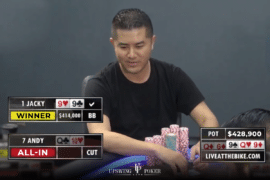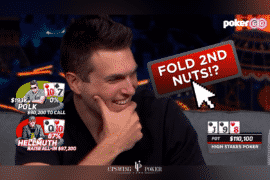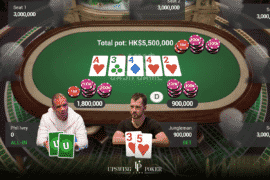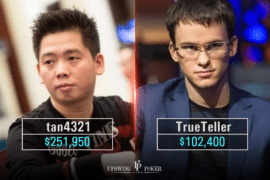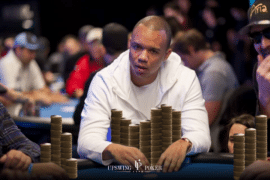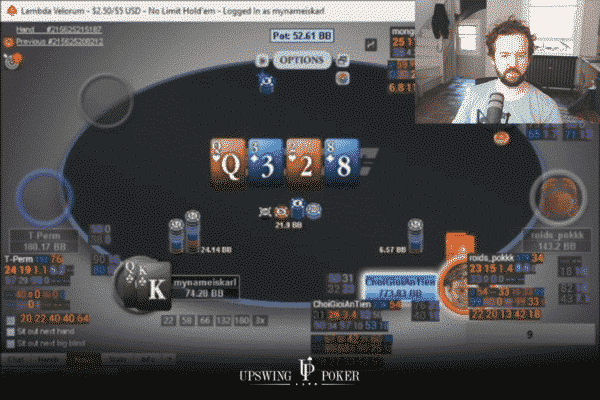
How to Play Strong Hands in a 3-Bet Pots (Hand Examples)
If you want to crush poker in 2021, you need to be an expert in 3-bet pots.
Which is why for today’s article, we’re going to be reviewing a few hands from a recent 500NL Zoom session played by cash game pro and Upswing Lab coach Fried ‘mynameiskarl’ Meulders.
The focus of this review is going to be on playing strong hands in 3-bet pots. We’ll be specifically discussing topics like:
- Optimal bet-sizing
- Raising in position
- Thin value betting
With all of these hands, I’ll be summarizing Fried’s thought process as well as providing an analysis of solver solutions on these hands that were done after the session. The source material for this article is Fried’s recent “Running Hot at 500NL Zoom” series in the Upswing Lab.
(Note: If you’re a Lab member, click here to watch Fried’s new video series. Not a Lab member yet? Join now to upgrade your No Limit Hold’em skills for 2021.)
Let’s get started.
Hand 1 – Interesting Turn Raise
The effective stack in this hand is around 110 big blinds (bb).
Preflop: Fried is dealt K♣ Q♣ in the Hijack.
Fried raises to 2.15bb. Big Blind 3-bets to 11bb. Fried calls.
Flop (21.9bb) Q♥ 3♦ 2♥
Big Blind checks. Fried checks.
Turn (21.9bb) Q♥ 3♦ 2♥ 8♦
Big Blind bets 6.57bb. Fried raises to 24.14bb. Big Blind calls.
River (70.18bb) Q♥ 3♦ 2♥ 8♦ 4♣
Big Blind checks. Fried checks.
Showdown
Villain mucks J♥ J♦
Fried wins 70.18bb
Preflop and Flop Analysis
Our first hand begins with Fried making a standard open with K♣ Q♣. The player in the Big Blind 3-bets to around 5 times the open, which Fried calls.
The flop is pretty good for Fried, hitting top pair with a good kicker on a fairly dry board. After the Big Blind checks, Fried must decide whether to check-back or bet small. Villain’s range here is going to be pretty tight given that he 3-bet from the BB, and Fried states upfront that a check from the Big Blind on such a disconnected board seems suspicious.
Fried goes on to explain that villain’s continuing range vs a bet will break down into 2 categories:
- Trapping hands that will check-raise like AQ and overpairs
- Medium-strength check-calling hands like weak top pairs and middle pairs like TT and JJ
In this situation, the advantage of betting is that we can build the pot against range number 2, and hopefully get three streets of value. However, we are put in, “A world of pain,” as Fried describes it, when we run into range number 1 and are check-raised.
After outlining these different scenarios, Fried decides to check. His decision to check comes down to both players’ positions along with previous reads on Big Blind suggesting he’s a tricky / aggressive player. Before heading to the flop Fried states that he would usually bet flop here if he had opened from the button rather than the hijack.
Note: Want to know how to play every hand in every common preflop situation? Get instant access to extensive preflop charts and lessons (for cash games, heads-up and tournaments) when you join the Upswing Lab training course. Lock your seat now!
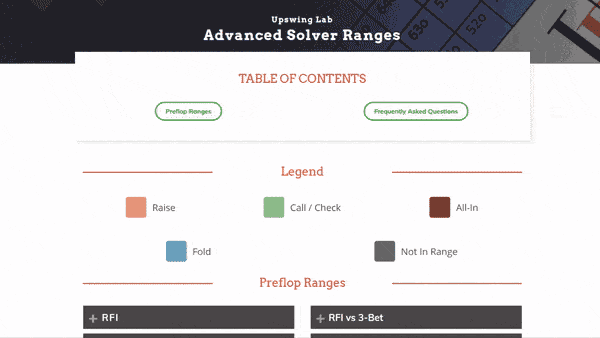
The Advanced Solver Ranges for cash games — one of five sets of preflop charts in the Upswing Lab.
Turn Analysis
The turn is a safe card for Fried. The ⅓ pot bet from the Big Blind suggests even more that K♣ Q♣ is the best hand. It’s most likely our opponent has a middle pair type hand like JJ or TT, which motivates Fried to raise for value.
River Analysis
Fried makes a mistake here and checks back river. This is one of those situations in poker where you quickly realize you made a mistake right after you click the button.
Fried acknowledges he should’ve trusted his read here and jammed river. Particularly after checking back flop and all the draws missing on river, Fried is in an excellent position here to get looked up light by a middle pair type hand from the Big Blind. He’ll have to settle for the 70bb pot.
Hand 2 – Going for the Stack with a Turned Monster
The effective stack in this hand is 100bb.
Preflop: Fried is dealt 9♣ 8♣ on the Button.
Fried raises to 2.31bb. Small Blind 3-bets to 10bb. Fried calls.
Flop (20.4bb) A♥ 8♦ 2♦
Small Blind bets 5.5bb. Fried calls.
Turn (31.4bb) A♥ 8♦ 2♦ 9♠
Small Blind bets 20.8bb. Fried raises all-in to 84.5bb. Small Blind folds.
Preflop and Flop Analysis
Fried has an easy open and call preflop with his suited connector. He also makes a standard flop call with middle pair here against the ¼ pot bet from villain.
Turn Analysis
Villain sizes up on his turn double-barrel with a ⅔ pot bet. Fried has turned a fairly strong two pair and has to decide whether to continue to call or to shove. Fried lays out his strategy:
I think I’m going to want to fast-play some of my vulnerable strong hands, so 98 would probably be the weakest one. I don’t think I’m jamming A9, and I’m not going to jam any set. Our potential bluffs are some flush draws that turned combo draws and hands like that.
Following the session, Fried reviewed this hand in Simple Postflop and the solver confirmed that 98 should go all in on this turn 100% of the time. We also learned that he should shove 9♦ 7♦ and 7♦ 6♦ some percentage of the time as bluffs to balance his range.
Hand 3 – Value Betting Top Pair
The effective stack in this hand is 110bb.
Preflop: Fried is dealt K♥ J♥ in the Small Blind.
Button raises to 2.7bb. Fried 3-bets to 11.04bb. Button calls.
Flop (22.78bb) J♣ 7♣ 6♥
Fried bets 14.35bb. Button calls.
Turn (51.48bb) J♣ 7♣ 6♥ 8♦
Fried bets 32.43bb. Button calls
River (116.35bb) J♣ 7♣ 6♥ 8♦ 6♦
Fried bets all-in for 52.17BB. Button folds.
Flop Analysis
Fried explains that on flops with this type of texture we will oftentimes want to use a bigger bet size than the standard ⅓ pot bet. The specific size we choose depends on our overall strategy but it can range from anywhere between ½ to a full pot-sized bet.
With K♥ J♥ here, the goal with making a bigger bet is to get added value and get more folds on flop before the board gets potentially messy on the turn. Fried bets roughly ⅔ pot and villain calls.
Turn Analysis
The turn 8♦ is not what Fried was hoping for in this case as it connects well with Button’s calling range. There are currently 51.48bb in the pot with effective stacks at 84.6bb.
Fried explains that our hand is still good enough to bet. However, we should plan on checking this turn at least some percentage of the time. He adds that there are a lot of bad rivers that can come out too.
Fried elects to bet the turn around ⅔ of the pot again, villain calls, and we head to the river with our fingers crossed.
Following the session, Fried reviewed this hand in Simple Postflop, and the solver solution suggested to not bet turn with K♥ J♥. The best line Fried could’ve taken with K♥ J♥ would have been to check-call the turn. Meanwhile hands like pocket kings and aces would be good overbet shoves on the turn, and AJ would make for a good check-raise all-in.
River Analysis
Not the worst river in the world, but once again Fried has a difficult decision to make. There are 52.17 BBs behind, which translates to about a 44% pot bet.
Fried has two choices here:
- Option 1: Shove and hope to get called by a worse jack or middle pair.
- Option 2: Check and hope to bluff-catch when villain shoves a missed draw.
Fried decides to shove and villain folds.
As mentioned earlier, the best line for fried with K♥ J♥ would’ve been to check turn. However, after betting turn, the solver agreed with this river shove. In this case, the low board-pairing river allows us to shove all of our Jx hands profitably. Interestingly, we have basically no check-calling range here, and opt instead to jam nearly 100% of our value hands.
Final Thoughts
When thinking about ‘tough decisions in 3-bet pots’ we often imagine big bluffs and heart-stopping hero calls. But the truth is it can be just as difficult to correctly play our strong hands in 3-bet pots as our marginal holdings and bluffs.
Its important to note that even great players like Fried make mistakes in these spots. However, one key factor separating the elite players from the rest of the field is that they will go back and review every spot they aren’t certain about. Keep this in mind as you’re working on your own game.
We hope this article provided you with some helpful insights on what to think about when you’re in similar spots with your good hands, and if you’re looking for more help on this topic I’d encourage you to join the Upswing Lab.
For further reading on 3-bet pots, check out: Single-Raised Pots vs 3-Bet Pots: How Should Your Strategy Differ?
As always, please post any comments or questions below and we’ll see you next time!


